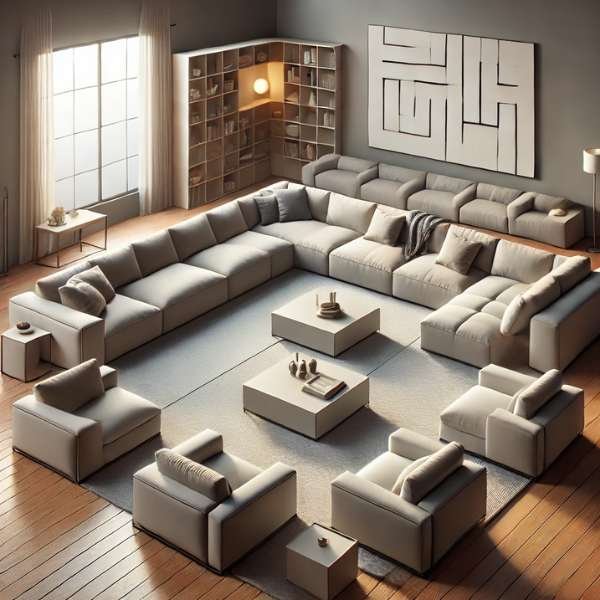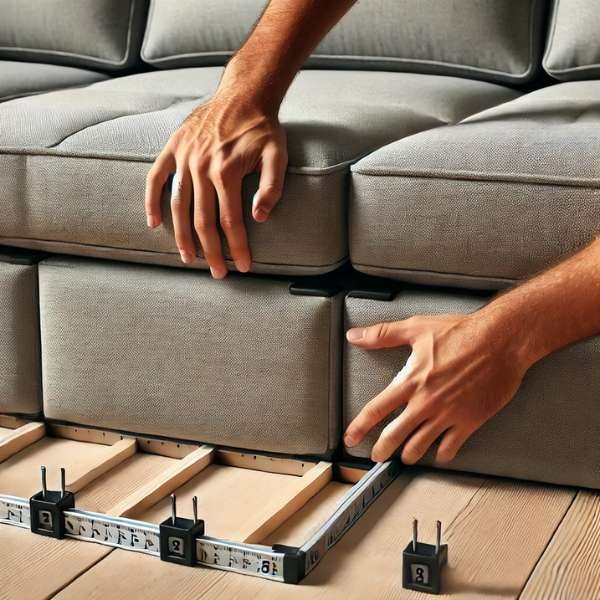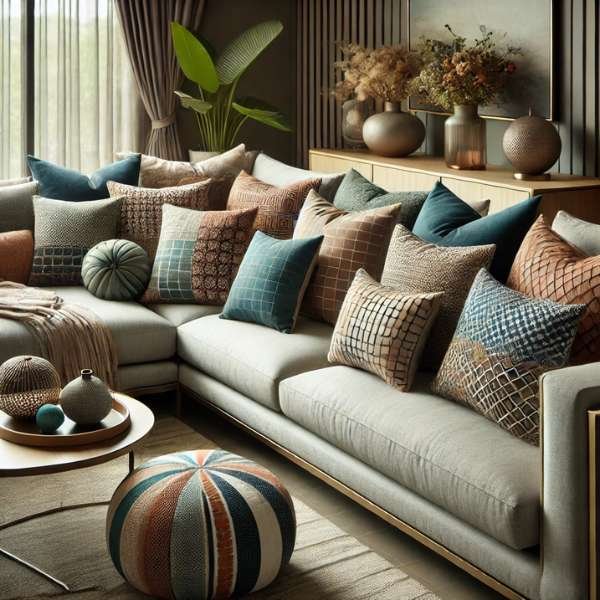Connecting a sectional couch may also seem like a frightening challenge, however with the proper approach, it may be extraordinarily easy. How to connect sectional sofa together is a commonplace question among owners who want to create an unbroken, snug seating arrangement. Whether you’re managing multiple pieces or just want to steady some sections, well-connecting your Sectional guarantees it remains strong and cohesive. In this manual, we’re going to stroll you through the steps to correctly be part of your Sectional sofa, so you can enjoy a stylish and useful centerpiece in your residing room.
Why Connecting Your Sectional Sofa Matters

It’s tempting to think, “Why bother connecting the sections at all?” After all, just placing them together might seem sufficient. However, without proper connection, sections tend to drift apart. This not only makes your setup look awkward and incomplete, but it can also make sitting uncomfortable. Imagine trying to relax, only to have the sofa pieces slide apart, leaving you with an unwanted gap! Moreover, properly connected sections create a sturdy, unified structure, ensuring your sectional sofa looks polished and offers the best comfort for you and your guests.
Connecting your sectional couch properly ensures balance, comfort, and toughness. Disassembling it without care can result in damage, reducing its lifespan. By gaining knowledge of how to take apart a sectional sofa effectively, you’re making future moves or rearrangements hassle-loose. Plus, reassembling it will be less complicated, retaining each piece securely connected for a cohesive appearance and experience.
Understanding Sectional Sofas
What Is a Sectional Sofa?
Sectional sofas aren’t your typical one-piece couches. Instead, they’re composed of multiple segments, including corner units, chaise lounges, and straight pieces. These sections can be rearranged in numerous configurations, adapting to your space’s layout. Whether you want an L-shape for a compact area or a U-shape for larger living rooms, regional sofas provide the flexibility to change your room’s appearance and functionality with ease. This versatility is what makes regional sofas a favorite among homeowners.
Types of Sectional Sofas You Might Have

Not all sectional sofas are created equal. There are various types, each catering to different room setups. L-shaped sectionals are popular for placing against walls, while U-shaped sectionals create a more communal space, perfect for large rooms or open living areas. Then there are modular sectionals, where each piece can stand alone or be attached to other pieces, offering endless customization. By understanding the type of region you have, you’ll know how best to connect and arrange the pieces for both function and aesthetics.
Preparing Your Space Before Connecting
Measuring Your Room for the Best Fit

Before you even think about connecting your sectional, grab a tape measure and size up your space. Sectionals, by their nature, are large and can easily overwhelm a room if not planned correctly. Make sure there’s ample space around the sofa for people to walk through and enough room for the other furniture in your living area. Jot down the dimensions of the room and consider how the sectional will fit within those confines.
Choosing the Ideal Layout for Your Sectional Sofa

Now that you’ve measured the room, it’s time to visualize the layout. Do you want your sectional to frame a cozy conversation corner, or should it face the television for optimal viewing? Perhaps you have a fireplace that serves as the room’s focal point, and you want the sofa to complement that. Deciding on the sofa’s placement before connecting the pieces will save you time and effort. Think about traffic flow as well—how will people move around the room with the sectional in place?
Tools You’ll Need to Connect Sectional Sofas
Must-Have Tools for Easy Assembly

Most sectional sofas come with everything you need to connect them. However, having a few additional tools on hand can make the job smoother and faster. A simple screwdriver, rubber mallet, and pliers can be lifesavers when it comes to tightening connectors or adjusting pieces that don’t quite fit on the first try. These tools will help ensure a secure, snug connection, giving you peace of mind that your sectional won’t shift or come apart during use.
Are All Sectional Sofas the Same? Know Your Sofa’s Mechanism

Not all sectionals connect the same way. Some use metal brackets that lock the pieces in place, while others rely on interlocking clips made of plastic. Before you start, consult your sofa’s manual to understand its specific connection mechanism. This will save you a lot of frustration during the assembly process, as knowing the right technique for your sectional’s design makes the job much easier.
Finding the Connecting Pieces
Identifying the Connectors on Your Sectional Sofa

The first step in connecting your regional is to find the connectors. These are usually located on the sides of each section. They might look like metal brackets or plastic clips designed to interlock. Once you’ve identified them, take a moment to familiarize yourself with how they fit together, so you’ll know exactly what to do when it’s time to assemble the sections.
Where to Buy Extra Connectors If Needed

Sometimes, you might find that your regional is missing a connector, or you may want to reinforce the existing ones for added stability. Thankfully, most hardware stores and online retailers sell replacement connectors designed to fit a variety of regional models. Having a few extra on hand can also be helpful if you ever decide to rearrange or move the sofa to a new space.
Step-by-Step Guide to Connecting Your Sectional Sofa
How to Align the Sofa Sections Correctly

Place each section of the sofa in the room according to your desired layout. Alignment is crucial here—ensure the sections are perfectly lined up before trying to connect them. This may require some patience, but taking the time to get this step right will prevent future frustration. Once the pieces are aligned, you’ll be ready to move on to the actual connection process.
Locking the Sections in Place Without a Hassle

With the sections aligned, it’s time to lock them into place. Lift one section slightly to allow the connectors to interlock. You might need to apply a bit of pressure to secure them, but be cautious—forcing the connection can cause damage. If you’re struggling to get the sections to lock, check your alignment and make any necessary adjustments. Once everything clicks into place, give the sofa a gentle push to ensure the connection is tight and secure.
Troubleshooting Common Issues
My Sectional Sofa Won’t Stay Together: What to Do

If your sectional sofa keeps coming apart, the problem is likely due to loose or worn-out connectors. Replacing the faulty connectors can solve this issue. If the sections aren’t properly aligning, take the time to adjust them until everything fits correctly. This small adjustment can make a big difference in keeping your region secure.
Preventing Gaps Between Sections

One of the most common complaints with regional sofas is the appearance of gaps between the sections. This typically happens when the connectors aren’t fully engaged or if the floor is uneven. To prevent this, ensure that the floor is level and that the connectors are properly locked. Gaps not only look unattractive but can also cause discomfort for anyone sitting on the sofa.
Caring for Your Connected Sectional Sofa
Maintaining the Shape and Stability of Your Sofa

Once your sectional is connected, it’s important to maintain its stability over time. Check the connectors periodically to ensure they haven’t loosened. Keeping an eye on the connectors will help prevent the sofa from shifting or coming apart unexpectedly. Additionally, fluff the cushions regularly to maintain their shape and keep your region looking fresh and inviting.
Cleaning and Protecting the Joints

Dust and debris can build up in the connectors, making it harder for the pieces to stay together. Use a vacuum cleaner with a brush attachment to clean around the joints and keep them free from dust. Applying a small amount of lubricant to the connectors can also ensure that they stay functional, preventing wear and tear over time.
Enhancing the Look of Your Connected Sofa
Adding Accessories to Hide Section Gaps

Even with the first-class connection, small gaps among sections can nonetheless appear. If those gaps hassle you, don’t forget the use ornamental pillows or throws to cover them. Not best do those accessories disguise the gaps, but, they also upload a further layer of style and coziness to your sofa setup.
Styling Tips for a Seamless Sofa Look

Achieving a continuing appearance doesn’t forestall connecting the sections. Pay interest to the colors, textures, and patterns of the cushions and add-ons you use. Coordinating those factors with the general layout of the room can assist your regional blend superbly into the gap. Whether you pick out formidable patterns or subtle tones, make certain the sofa enhances the room’s decor.
When to Call a Professional for Help
Knowing When DIY Isn’t Enough

While connecting a sectional sofa is usually a DIY-friendly undertaking, there are instances when professional help may be important. If the connectors are damaged or if you’ve attempted the entirety and your sofa still gained’t stay together, calling in a professional fixtures technician could prevent a number of time and frustration. Professionals have the equipment and understanding to restore any issue, ensuring that your sectional remains securely related for years to come.
conclusion:
Successfully connecting your sectional sofa brings each functionality and style to your living area. With each piece securely in the vicinity, you may enjoy a unified, comfortable seating association that complements your own home. Following the proper steps no longer only guarantees stability but also presents the overall aesthetic of your room. By preserving your sofa over time, you’ll experience years of consolation and fashion, developing welcoming surroundings for rest or gatherings with family and buddies.

